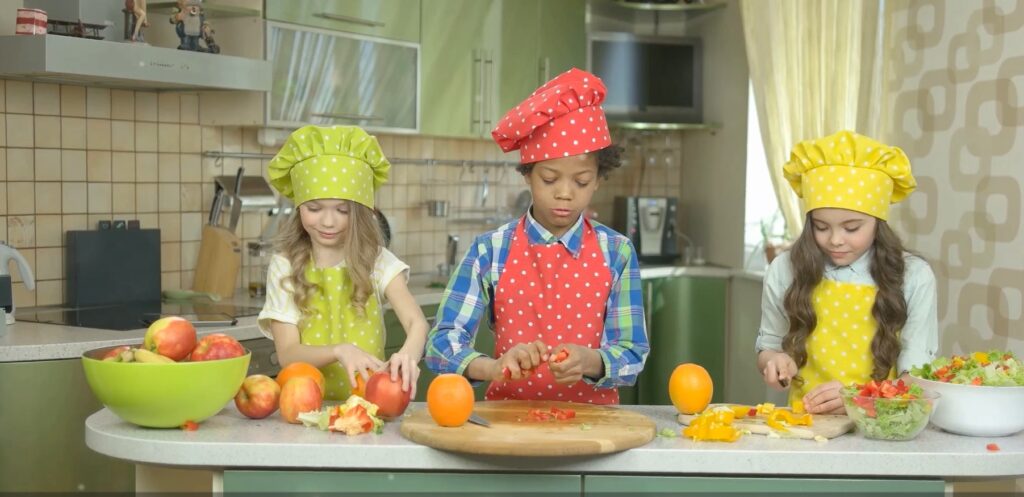Jamie Oliver crystallized his vision for a food revolution in his TED Talk. At the Charlton Manor Primary School in London, head teacher Timothy Baker is putting his idea into action by offering not just food education but education centered on food.
Watch the video and choose the right answer a)-d) to the questions below:
1. According to the video, what was the primary reason the head teacher at Chuckle Manor wanted to introduce food education in the school?
a) To improve the children’s academic performance
b) To address the growing problem of obesity
c) To teach the children how to cook different meals
d) To introduce a new and exciting curriculum topic
2. What was the main approach the head teacher used to integrate food education into the school’s curriculum?
a) Replacing traditional lessons with cooking classes
b) Establishing a new department for food and nutrition
c) Incorporating food-related themes into existing subjects
d) Bringing in external chefs and nutritionists to teach the students
3. What were the key benefits the video highlighted that the students at Chuckle Manor gained from the food education program?
a) Improved physical health and concentration
b) Increased opportunities for outdoor activities
c) Enhanced understanding of food production
d) All of the above
4. What was one of the main challenges the school initially faced when implementing the food education program?
a) Resistance from parents and the local community
b) Lack of funding for the necessary resources
c) Difficulty finding qualified teachers to deliver the lessons
d) Convincing other teachers to adjust their lesson plans
5. How did the school’s garden and chickens contribute to the food education program, according to the video?
a) They provided a hands-on learning environment for the students
b) They helped to improve the school’s self-sufficiency in food production
c) They gave the students a greater appreciation for where their food comes from
d) All of the above
6. What was the overall impact of the food education program at Chuckle Manor, as suggested by the video?
a) It improved the students’ physical and mental wellbeing
b) It inspired other schools to implement similar programs
c) It made a significant difference in the lives of the students
d) All of the above
Key: 1.B; 2. C; 3. D; 4. A; 5. D; 6. D
Glossary
- obesity – the state or condition of being very fat or overweight
- to run for one’s life – to run to escape from great danger
- polytunnel – a large tunnel made of polythene and used as a greenhouse
- reluctance – lack of willingness
- picky – very careful about choosing only what they like
Practice makes perfect
Complete the article extract with one word in each gap:
A New Theory of Obesity
(…) meal portions today are larger, food more abundant, and many of us are eating more calories 1. …… people did decades ago. But with temptations 2. ……. plentiful, almost all Americans could 3. …… overeating—yet 4. …… good number do not. That, Hall (Nutrition researcher) thinks, is 5. …… real nutrition mystery: What factors, for some people, might be acting to override the body’s inborn satiety mechanisms that otherwise keep our eating 6. ……. check? (…)
Hall likes to compare humans to automobiles, pointing 7. …… that both can operate 8. ….. any number 9. …… energy sources. In the case of cars, it might be diesel, high-octane gasoline 10. ……… electricity, depending 11. …… the make and model. Similarly, humans can and do thrive on any number of diets, depending on cultural norms and what 12. …… readily available. (…) But (…) in recent decades the food supply has changed in ways to which our genes—and our brains—have had very little time to adapt. And it should come as 13. ……. surprise that each of us reacts differently to that challenge.
At the end of the 19th century, most Americans lived in rural areas, and nearly half made their living on farms, 14. ……. fresh or only lightly processed food was the norm. Today most Americans live in cities and buy rather 15. …… grow their food, increasingly in ready-to-eat form. An estimated 58 percent of the calories we consume and nearly 90 percent of all added sugars come from industrial food formulations made 16. ….. mostly or entirely of ingredients—whether nutrients, fiber or chemical additives—that are not found in a similar form and combination in nature. These are the ultraprocessed foods, and they range 17. ….. junk food such as chips, sugary breakfast cereals, candy, soda and mass-manufactured pastries 18. ….. what might seem like benign or even healthful products such as commercial breads, processed meats, flavored yogurts and energy bars. (…)
Key: 1. than; 2. so; 3. be; 4. a; 5. the; 6. in; 7. out; 8. on; 9. of; 10. or; 11. on; 12. is; 13. no; 14. where; 15. than; 16. up; 17. from;18. to
Discuss:
- How much of a problem is obesity in your country?
- Why is obesity increasing?
- Is there anything governments should do to combat obesity?
- Would you agree that obesity among children is their parents’ fault?
- Do you think obese people should pay higher medical charges?
- Should there be a “fat tax” on food that is very high in calories?
- What do you think of the “big is beautiful” phenomena in the USA?
Watch and revise!
Jamie Oliver’s Food Revolution is Transforming Schools.
https://www.cloud.worldwideschool.pl/index.php/s/paJkGmCzdq4P6s4
(4943)






